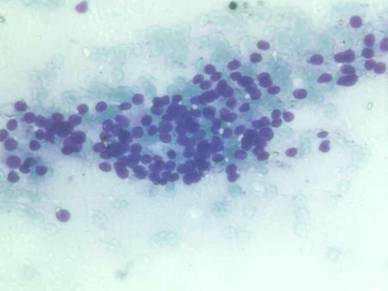Trends in Cytomorphological Study of Thyroid lesions: A two year prospective study in the malwa region of central India
Abstract
Background: Thyroid lesions are commonly encountered in daily clinical practice. However, excision of thyroid lesions is associated with risk. Hence an effective preliminary test is needed to avoid unnecessary surgery. An assessment of thyroid lesion by FNAC has proved to provide early diagnosis and hence helps in avoiding invasive surgery.
Aims and Objectives: The purpose of present study was to study various cytomorphological features of thyroid lesions in the tertiary teaching hospital of Malwa region with respect to age, sex and to categorize them into neoplastic and non-neoplastic lesions.
Materials and methods: FNAC was performed on patients who presented with thyroid swelling in department of pathology of Sri Aurobindo Medical College and PG Institute, from 1st January 2014 to 31st December 2015.
Results: Out of 186 patients in our study group 161(86.56%) were benign, 23(12.37%) were malignant and 2 were inconclusive. Benign follicular lesion 108 (67%) was commonest under non-neoplastic category and follicular neoplasm 19 (82.6%) under neoplastic category. Male to female ratio was 1:4.
Conclusion: FNAC plays an important role in thyroid lesions as it is safe, cost effective and also helps in selections of patients for surgery, thus minimizing risk associated with surgery.
Downloads
References
2. Unnikrishnan AG, Menon UV. Thyroid disorders in India: An epidemiological perspective. Indian J Endocr Metab 2011;15:78-81. [PubMed]
3. Gabalec F, Cap J, Ryska A, Vasatko T, and Ceeova V. Benign fine needle aspiration cytology of thyroid nodule: to repeat or not to repeat? European Journal of Endocrinology 2009;16:933-37. [PubMed]
4. Abu-Nema T, Ayash K, Tibblin S : Role of aspiration biopsy cytology in the diagnosis of cold solitary thyroid nodules. Br J Surg 1987;74:203. [PubMed]
5. Tunridge WM : The spectrum of thyroid disease in a community. The Wicham survey. Clin Endocrinol 1997;17:481-493. [PubMed]
6. Mangshetty SS, Jewargikar R, Andola SK. Fine needle aspiration cytology of 220 Thyroid lesions with histopathological correlation. Int J Res Health Sci 2014;2:243-53.
7. Sengupta A, Pal R, Kar S, Zaman FA, Senguota S, Pal S. Fine needle aspiration cytology as the primary diagnostic tool in thyroid enlargement. J Nat Sc Biol Med 2011;2:113-118. [PubMed]
8. Yassa L, Cibas ES, Benson CB, Frates MC, Doubilet PM, Gawande AA,et al. Long term assessment of a multidisciplinary approach to thyroid nodule diagnostic evaluation. Cancer 2007;111:508-16. [PubMed]
9. Handu U, Garg S, Mohan H, Nagarkar N. Role of the fine needle aspiration cytology in diagnosis and management of thyroid lesions: A study on 434 patients. J cytol 2008;25:13-7.
10. Jogai S, AI-Jassar A, Temmim L, Dey P, Adesina AO, Amanguno HG. Fine needle aspiration cytology of the thyroid: A cytohistological study with evaluation of discordant cases. Acta Cytol 2005;49:483-8. [PubMed]
11. Jain S, Nayak R, Totade S, Shukla N. Clinico-pathological correlation of thyroid swellings. Int J Med Res Rev 2014;2:553-60.
12. Bamanikar S, Soraisaham P, Jadhav S, Kumar H, Jadhav P, Bamanikar A. Cyto-histology correlation and clinical correlation of thyroid gland lesions: A 3 year study in tertiary hospital. Clin Cancer Investig J 2014;3:208-12.
13. Mangshetty SS, Jewargikar R, ASK. Fine Needle Aspiration Cytology of 220 Thyroid Lesions. Histopathological correlation. Int J Res Health Sci 2014;2:243-53.
14. Chand N, Bedi S, Kaur N, Gulati B, Sharma J, Bajwa D, Garg LN. Clinico-Cytological Spectrum Of Thyroid Mass Lesions Using FNAC And Corellating Biopsy. NJIRM 2015; 6: 84-89.
15. Mittal A, Ahmad F, Dutta S, Nizammudin S, Awasthi S, Kumar A, Vyas P. Use and Accuracy of Fine Needle Aspiration Cytology in Thyroid Lesion: Our Experience in a Tertiary Teaching Hospital in North India. Int J Sci Stud 2015;3:95-100.
16. Orell SR, Sterrett GF, Whitaker D. Thyroid. In: Fine Needle Aspiration Cytology. 4th ed. Philadelphia: Churchill Livingstone;2005.p.125-64.
17. Gamboa-Dominguez A, Candanedo-Gonzalez F, Uribe- Uribe NO, Angeles-Angeles A. Tall Cell variant of papillary thyroid carcinoma. A cytohistologic correlation, Acta Cytol 1997;41:672-6.
18. Yeh MW, Demircan O, Iturate P, Clark OH. False-negative fine-needle aspiration cytology results delay treatment and adversely affect outcome in patients with thyroid carcinoma. Thyroid 2004;14:207-15.
19. Bellantone R, Lombardi CP, Raffaelli M, Traini E, De Crea C, Rossi ED, et al. Management of cystic or predominantly cystic thyroid nodules:The role of ultrasound-guided fine-needle aspiration biopsy.Thyroid 2004;14:43-7.
20. Basharat R, Bukhari MH, Saeed S, Hamid T. Comparison of Fine Needle Aspiration Cytology and Thyroid Scan in Solitary thyroid Nodule. Pathology Res Int 2011;2011:754041.doi:10.4061/2011/754041.



 OAI - Open Archives Initiative
OAI - Open Archives Initiative


